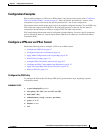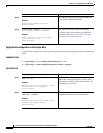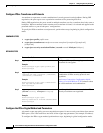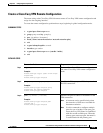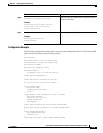
9-15
Cisco 819 Series Integrated Services Routers Software Configuration Guide
OL-23590-02
Chapter 9 Configuring Security Features
Configuring VPN
Create a Cisco Easy VPN Remote Configuration
The router acting as the Cisco Easy VPN client must create a Cisco Easy VPN remote configuration and
assign it to the outgoing interface.
To create the remote configuration, perform these steps, beginning in global configuration mode:
SUMMARY STEPS
1. crypto ipsec client ezvpn name
2. group group-name key group-key
3. peer {ip address | hostname}
4. mode {client | network-extension | network extension plus}
5. exit
6. crypto isakmp keepalive seconds
7. interface type number
8. crypto ipsec client ezvpn name [outside | inside]
9. exit
DETAILED STEPS
Command or Action Purpose
Step 1
crypto ipsec client ezvpn name
Example:
Router(config)# crypto ipsec client ezvpn
ezvpnclient
Router(config-crypto-ezvpn)#
Creates a Cisco Easy VPN remote configuration
and enters Cisco Easy VPN remote configuration
mode.
Step 2
group group-name key group-key
Example:
Router(config-crypto-ezvpn)# group
ezvpnclient key secret-password
Router(config-crypto-ezvpn)#
Specifies the IPSec group and IPSec key value for
the VPN connection.
Step 3
peer {ip address | hostname}
Example:
Router(config-crypto-ezvpn)# peer
192.168.100.1
Router(config-crypto-ezvpn)#
Specifies the peer IP address or hostname for the
VPN connection.
Note A hostname can be specified only when
the router has a DNS server available for
hostname resolution.
Note Use this command to configure multiple
peers for use as backup. If one peer goes
down, the Easy VPN tunnel is established
with the second available peer. When the
primary peer comes up again, the tunnel is
re-established with the primary peer.



